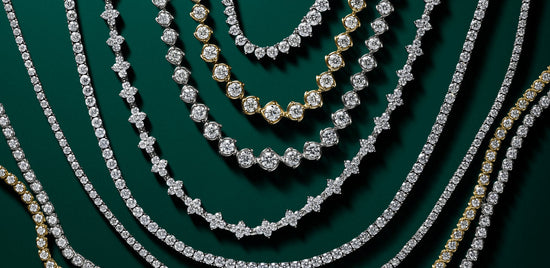Discover the allure of pink argyle diamonds and what makes them so valuable. Our guide explores the history, characteristics, and investment potential of these exquisite gems, and showcases some of the most stunning pink argyle diamond jewelry designs on the market.
Whether you're a diamond enthusiast, collector, or simply looking for a unique gift, this is a must-read for anyone fascinated by the world of precious gemstones.
What is an Argyle Pink Diamond?
An Argyle Pink diamond is a rare type of diamond that is prized for its unique color. Argyle diamonds were mined in the East Kimberley region of Western Australia up until the end of 2020 when the mine closed for good. Although the are known for their distinctive pink and red hues, it remains a mystery exactly how natural pink diamonds become pink.
The term "argyle diamond" is used to refer to any diamond that is sourced from the Argyle mine, regardless of its pattern or color, as Argyle diamonds can range from red, to pink, to blue-violet.
Pink diamonds sourced elsewhere cannot be called “Argyle” and are graded with GIA. Argyle diamonds are graded with the Argyle Pink diamond scale discussed below.
While pink diamonds have been historically sourced from India, South Africa, Canada, Russia, and Brazil, over 90% of the world’s-supply of pink diamonds originates from the Argyle mine.

How can you tell if a pink diamond is Argyle?
Every Argyle diamond weighing above 0.08 cts has an engraved, laser-inscribed unique lot number along its girdle. The lot number connects the diamond to its official Argyle report.
While Argyle diamonds under eight points do not receive a certificate, they receive an Argyle Lot Number. Batches of small stones are given their unique lot numbers from the rough they were cut from.

What makes Argyle Pink Diamonds so special?
The uniqueness of the Argyle diamond comes from its bold color and scarcity.
Argyle diamonds can range from bluish-violet, to rich reds, and many tones of pink. Specifically, Argyle pink diamonds are known for their vibrant, saturated colors with tinges of red and purple, whereas pink diamonds from other regions often reflect a more salmon or orangy-pink color.
Their rarity also contributes to their prized status among jewelry lovers. There is a limited number of pink diamonds in existence, and it is speculated that there are only about 500 more gem-quality pink diamonds left to be discovered.
Only one carat of every million carats of rough diamond produced is suitable for sale on the market. This is why these diamonds are so highly sought after by collectors and are considered some of the most valuable diamonds in the world. Argyle diamonds are typically sold for 100 times the value of an equivalent white diamond.
Additionally, pink diamonds are exceptionally difficult to polish—taking three to four times longer polish than a white diamond—due to its structure.

How are Argyle Diamonds graded?
While the 4 C’s (Cut, Color, Clarity, and Carat) are still considered in the grading of Argyle pink diamonds, there is an additional system used to grade the shade of the pink.
The Argyle Pink Diamond Grading System is internationally recognized and used to grade all pink diamonds.
There are 4 tiers to the shade scale for pink Argyle diamonds:
- PP (Purplish Pink);
- P (Pink);
- Pink Rosé (PR);
- PC (Pink Champagne)
Additional categories for Argyle diamonds are:
- R (Red)
- puRED (Purplish Red)
- BL (Blue Violet)
After being placed in a shade category, the diamond’s color is graded by intensity, ranging from 1 (HIGH) to 9 (LOW). However, Pink Champagne diamonds will not receive an intensity grade higher than 3. Therefore the highest quality of Pink Champagne diamond is 3PC, whereas the highest qualities of Purplish Pink, Pink, and Pink Rosé diamonds are 1PP, 1P, and 1PR.

How do pink diamonds become pink?
How pink diamonds become pink is a mystery that continues to vex experts!
While we know that nitrogen is responsible for giving yellow diamonds their color, and boron gives blue diamonds theirs, gemologists and scientists are still unclear as to what exactly gives pink diamonds their rose-colored hue.
A leading theory is that the pink diamonds “get their color from a structural defect known among scientists as “plastic deformation” which is when the diamond is forced to the Earth’s surface and the structure of the diamond somehow becomes altered, causing a deformation” (Cape Town Diamond Museum).
The defect causes the stone to absorb light differently and reflect a pink hue. However, the pressure involved in the process makes Argyle diamonds prone to inclusions, making high-quality diamonds from this region even more exceptionally rare.

Is an Argyle diamond a good investment?
If you are fortunate enough to consider purchasing your very own Argyle pink diamond, you should understand that its worth not only comes from its remarkable beauty and rarity but also from its ratio of size to value.
As a long-lasting, durable heirloom with a guaranteed high resale value, Argyle Pink diamond jewelry is one of the best ways to invest in a highly concentrated form of wealth. With such a limited supply, the value of these coveted diamonds is expected to only increase with time.







